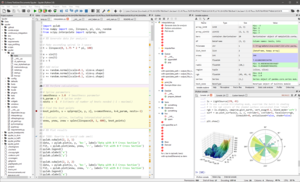Spyder (software)
 | |
 Screenshot of Spyder on Windows | |
| Original author(s) | Pierre Raybaut |
|---|---|
| Developer(s) | Spyder project contributors |
| Initial release | 18 October 2009[1][2] |
| Stable release | 5.2.1
/ 14 December 2021 |
| Repository | |
| Written in | Python |
| Operating system | Cross-platform |
| Platform | Qt, Windows, macOS, Linux |
| Type | Integrated development environment |
| License | MIT |
| Website | www |
Spyder is an open-source cross-platform integrated development environment (IDE) for scientific programming in the Python language. Spyder integrates with a number of prominent packages in the scientific Python stack, including NumPy, SciPy, Matplotlib, pandas, IPython, SymPy and Cython, as well as other open-source software.[3][4] It is released under the MIT license.[5]
Initially created and developed by Pierre Raybaut in 2009, since 2012 Spyder has been maintained and continuously improved by a team of scientific Python developers and the community.
Spyder is extensible with first-party and third-party plugins,[6] includes support for interactive tools for data inspection and embeds Python-specific code quality assurance and introspection instruments, such as Pyflakes, Pylint[7] and Rope. It is available cross-platform through Anaconda, on Windows, on macOS through MacPorts, and on major Linux distributions such as Arch Linux, Debian, Fedora, Gentoo Linux, openSUSE and Ubuntu.[8][9]
Spyder uses Qt for its GUI and is designed to use either of the PyQt or PySide Python bindings.[10] QtPy, a thin abstraction layer developed by the Spyder project and later adopted by multiple other packages, provides the flexibility to use either backend.[11]
Features[]
Features include:[12]
- An editor with syntax highlighting, introspection, code completion
- Support for multiple IPython consoles
- The ability to explore and edit variables from a GUI
- A Help pane able to retrieve and render rich text documentation on functions, classes and methods automatically or on-demand
- A debugger linked to IPdb, for step-by-step execution
- Static code analysis, powered by Pylint
- A run-time Profiler, to benchmark code
- Project support, allowing work on multiple development efforts simultaneously
- A built-in file explorer, for interacting with the filesystem and managing projects
- A "Find in Files" feature, allowing full regular expression search over a specified scope
- An online help browser, allowing users to search and view Python and package documentation inside the IDE
- A history log, recording every user command entered in each console
- An internal console, allowing for introspection and control over Spyder's own operation
Plugins[]
Available plugins include:[13]
- Spyder-Unittest, which integrates the popular unit testing frameworks Pytest, Unittest and Nose with Spyder
- Spyder-Notebook, allowing the viewing and editing of Jupyter Notebooks within the IDE
- Download Spyder Notebook
- Using conda: conda install spyder-notebook -c spyder-ide
- Using pip: pip install spyder-notebook
- Spyder-Reports, enabling use of literate programming techniques in Python
- Spyder-Terminal, adding the ability to open, control and manage cross-platform system shells within Spyder
- Download Spyder Terminal
- Using conda: conda install spyder-terminal -c spyder-ide
- Using pip: pip install spyder-terminal
- Spyder-Vim, containing commands and shortcuts emulating the Vim text editor
- Spyder-AutoPEP8, which can automatically conform code to the standard PEP 8 code style
- Spyder-Line-Profiler and Spyder-Memory-Profiler, extending the built-in profiling functionality to include testing an individual line, and measuring memory usage
See also[]
- List of integrated development environments for Python programming language
References[]
- ^ "spyder-ide/spyder at v1.0.0". GitHub. Retrieved 3 April 2017.
- ^ "(Python)(ANN) Spyder v1.0.0 released". 18 October 2009.
- ^ "Migrating from MATLAB to Python". Greener Engineering. et.byu.edu. Archived from the original on 2014-10-10. Retrieved 9 February 2014.
- ^ "Spyder review". review.techworld.com. Retrieved 9 February 2014.
- ^ "Spyder license".
- ^ "SpyderPlugins – spyderlib – Plugin development – Spyder is the Scientific PYthon Development EnviRonment". Archived from the original on 24 October 2013. Retrieved 9 February 2014.
- ^ "Pylint extension – Spyder 2.2 documentation". packages.python.org. Retrieved 9 February 2014.
- ^ "Reviews for spyder". apps.ubuntu.com. Retrieved 9 February 2014.
- ^ "Seznámení s Python IDE Spyder". fedora.cz. Archived from the original on 20 August 2013. Retrieved 9 February 2014.
- ^ "Spyder runtime dependencies". github.com. 21 February 2015.
- ^ "QtPy: Abstraction layer for PySide/PyQt4/PyQt5". github.com. 23 October 2015. Retrieved 28 December 2015.
- ^ "Spyder Documention – Features Overview". Spyder Project. Retrieved 2018-07-30.
{{cite web}}: CS1 maint: url-status (link) - ^ "Spyder Plugins List". Spyder Project. Retrieved 2018-07-30.
{{cite web}}: CS1 maint: url-status (link)
External links[]
- Free integrated development environments
- Free integrated development environments for Python
- Python (programming language) development tools
- Free mathematics software
- Free science software
- Python (programming language) software
- Software using the MIT license